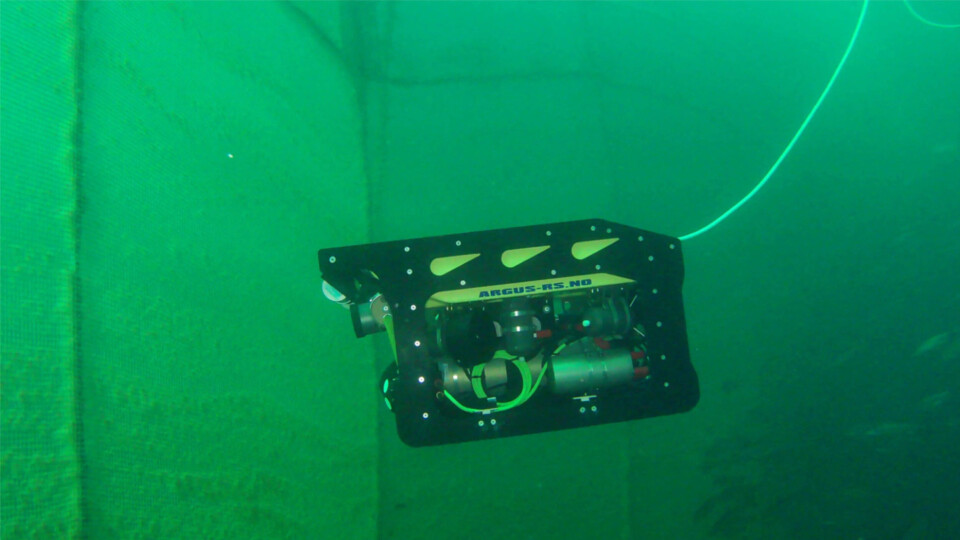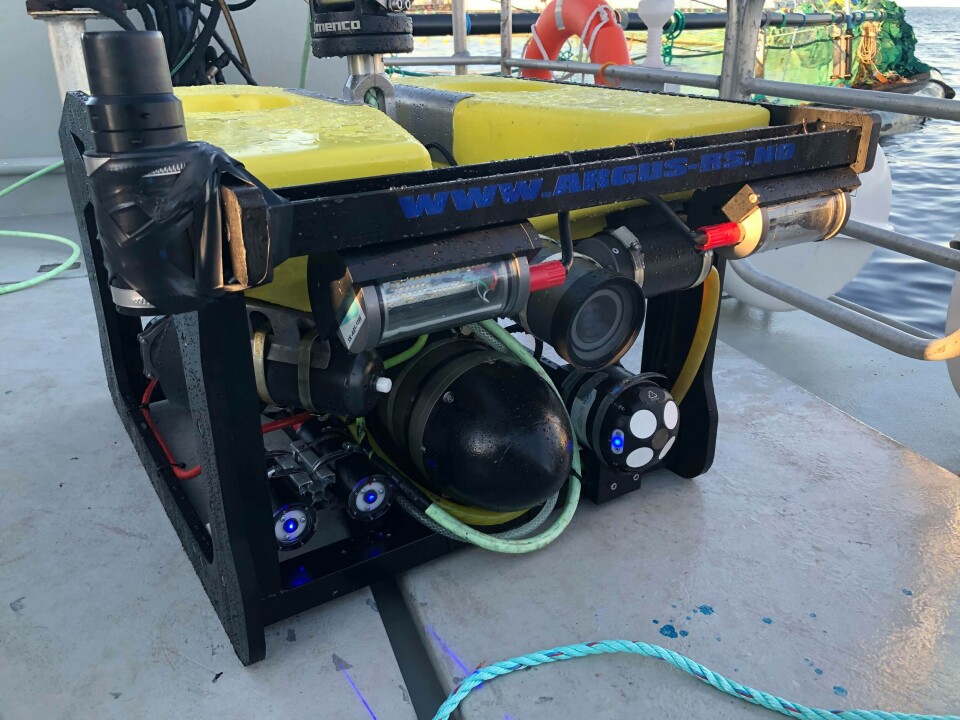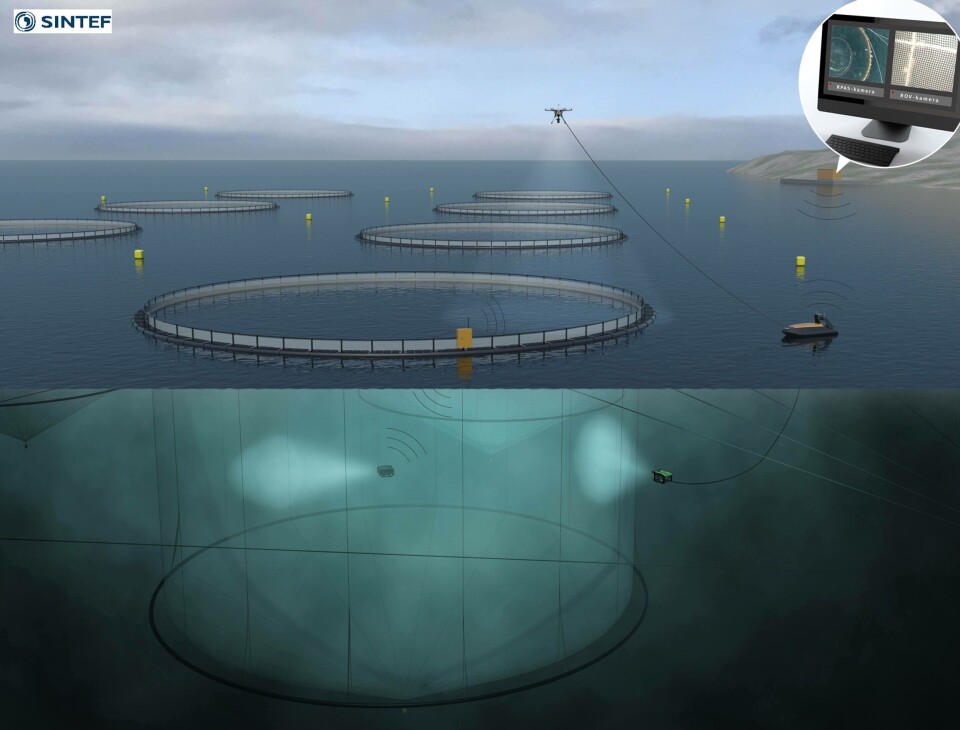
Self-driving ROV developed to speed up net inspections
A remotely operated vehicle (ROV) that navigates its own way around a salmon cage with much less input from its operator has been developed by researchers who believe it will speed up the job of inspecting nets.
ROVs equipped with a camera and sensors already do a lot of the inspection work that used to be done by divers. But these ROVs must be steered via a tether from the surface by a skilled pilot, whose attention is split between navigating the vehicle accurately around the edge of the cage – with control over little more than depth and heading – and doing the inspection itself.
Scientists from Norwegian research institute SINTEF have developed a prototype inspection ROV with a high degree of autonomous navigational capability which they say allows the operator to spend more time on the inspection, rather than navigation. This means the job can be done more quickly and efficiently.

Tracking the net
“If you can make the ROV ‘fly’ along the net autonomously, then the pilot can concentrate more on inspecting the quality of the net and deploying analytical equipment that is more complex to operate,” said Walter Caharija, a research scientist at SINTEF Ocean. He led the ROV project, known as Artifex, which built on work of former SINTEF researcher Per Rundtop in the MerdROV project.
The question the developers had to answer was how do you to get the ROV to track the contours of the net from a fixed distance as it travels around the inside of the cage?
This requires more than just knowing where the ROV is in the water. The vehicle also needs to know exactly where it is in relation to the net, which is constantly moving. That requires technology that can detect the net and accurately gauge the ROV’s distance from it, as well as calculating the vehicle’s speed along the net.
Doppler velocity log
The team that carried out the early work thought using a Doppler velocity log (DVL), horizontally mounted on the frame of the ROV, could be the solution. But they weren’t sure whether a DVL would be capable of “locking on” consistently to a surface as ill-defined as a fish net.
DVLs measure velocity relative to a boundary – such as the bottom – by analysing echoes bounced back from a hard surface. They are also able to measure distance from other types of surfaces accurately using a similar technique. However, these other types of surfaces tend to be a more clearly defined barrier, such as the seabed, rather than a mesh net.

Sensor fusion
The researchers contacted Nortek, a specialist in the designs, development and production of scientific instruments that apply the Doppler principle to underwater acoustics, which supplied a DVL1000 instrument that proved able to “see” the net as the ROV moved around the circumference of the cage.
The DVL is part of a package of navigational aids, which Caharija describes as a “sensor fusion”. Ultra-short baseline acoustic positioning (USBL), compass readings, a laser system and the on-board camera all contribute location data. But, in terms of maintaining distance from the cage net, it is the DVL that does the work.
The ROV is intended for use inside or outside the cage but has so far only been tested inside the cage.

Unmanned fish farms
Artifex and its successor projects could pave the way for completely unmanned fish farms, with monitoring and repair controlled remotely by personnel based on land, and repairs carried out by ROVs, rather than divers.
The Artifex team also aims to fit the ROV with a robotic arm to carry out net repairs, while project partners are developing an unmanned surface vessel (USV) to which an ROV could be tethered, along with a drone to assist inspections.
Moving fish farms further offshore is a growing trend as farmers seek to meet growing global demand for fish. So, the next step for the researchers is to move away from the relative calm of near-shore fish farms to test the ROV in deeper, rougher waters.
Low-cost techniques
The SINTEF team are doing this as part of the Exposed project, a joint venture between academic researchers, aquaculture companies and technology firms to develop new, low-cost techniques for many aspects of fish farming in more exposed locations.
Close to shore, a vessel can be attached to the cage, making interaction with the ROV tethered to it relatively straightforward. However, in more exposed locations with rougher seas, it may not be safe to attach the vessel to the cage, making the process of keeping it on station above the ROV a lot more complicated.
“In those conditions, tasks such as the launch and recovery of the ROV can be as big a challenge as actually operating it underwater,” said Herman Biørn Amundsen of SINTEF Ocean.
Time is precious
In practice, these added complications mean ROV missions in exposed fish farms are more vulnerable to being cut short by a closing weather window. This, in turn, makes any extra time that can be devoted to net inspection an even more precious commodity, accentuating the benefit of autonomous navigation using the DVL.
SINTEF is also working on a related project, CageReporter. Its main objective is to develop sensor systems for high-quality data acquisition from within fish farming cages using autonomous and non-tethered vehicles, and the transmission of the data acquired to land.























































